 Contents Among the Usage notes are the following Grammar Finders : Introduction Welcome to the new edition of Collins COBUILD English Usage, for students from intermediate to advanced level, and for teachers of English. With the help of the Collins Corpus, now totalling 4.5 billion words, we have been able to update and revise this title so that it describes how people actually use English now. What is usage? Usage deals with the essential details of language, involving aspects of grammar, meaning, idiom, and purpose. It looks at the way words are arranged to express a particular meaning or to do a particular job. Most of the statements in this book are not generalizations, because usage deals with all the things that are not covered by the general rules. However, there is no strict dividing line between grammar and usage.
Contents Among the Usage notes are the following Grammar Finders : Introduction Welcome to the new edition of Collins COBUILD English Usage, for students from intermediate to advanced level, and for teachers of English. With the help of the Collins Corpus, now totalling 4.5 billion words, we have been able to update and revise this title so that it describes how people actually use English now. What is usage? Usage deals with the essential details of language, involving aspects of grammar, meaning, idiom, and purpose. It looks at the way words are arranged to express a particular meaning or to do a particular job. Most of the statements in this book are not generalizations, because usage deals with all the things that are not covered by the general rules. However, there is no strict dividing line between grammar and usage.
For this reason, you will also find entries on the most important grammatical points in English, integrated into the main usage section of the book. Extensive cross-referencing helps you to move easily between entry-types. The book is divided into three main sections: Usage and Grammar, Topics, and a Reference section. The Topics and Reference sections are clearly marked in the shaded area at the side of each page. The Usage section A large number of the entries in the Usage section consist of short notes on individual words and phrases. Two words like although and though may be easily confused; or one word may need to go with another, for example afford needs to be preceded by can , could , or be able to .
Other entries are longer: they might deal with words that have a lot of meanings, or they might focus on function words; these are small words like and and that , which serve to express grammatical relationships between parts of a sentence. You can find out more about any of the grammatical terms that are used in the explanations by looking at the relevant Grammar Finder entry. Using the evidence from our American corpus, we have also updated the coverage of American English for this new edition. The Topics section The Topics section is divided into two subsections: (1) straightforward topics such as Meals, Places, and Transport, and (2) functional aspects of English such as Agreeing and disagreeing, Apologizing, Thanking, and Warning. It also covers certain areas of written English such as writing emails and letters. The Reference section The Reference section gives information on layout, rules, and formation in the following essential areas of English:
- Abbreviations
- Capital letters
- Days and dates
- Irregular verbs
- Measurements
- Nationality words
- Numbers and fractions
- Plural forms of nouns
- Punctuation
- Spelling
- Verb forms (formation of)
All the entries in each section are arranged in alphabetical order, and related areas are cross-referenced throughout.
The examples Thousands of real extracts from the constantly updated Collins Corpus are used to demonstrate the usage points. Where appropriate, they have been cut down or simplified, so that they help you to focus on the usage point that they illustrate. Our intention is that this should be a practical, comprehensive, and accessible guide to English usage. As well as being an easy-to-use reference book, we hope that it is written in a way that will encourage you to learn while browsing and enjoying at your leisure. COBUILD is always keen to know how the reference books and dictionaries are appreciated, and we have set up an email address (collins.elt@harpercollins.co.uk) for your comments and criticisms, so that future editions can continue to meet your needs. Guide to the Usage The aim of this book is to help learners of English to choose the right words and structures for the meaning they want to communicate.
Each entry is based on the latest evidence from the Collins Corpus, which now totals over 4.5 billion words. Both learners and teachers will find the book useful as an authoritative reference on how English is actually used today. To help you find what you want more easily, this new edition of Collins COBUILD English Usage has been divided into three sections: Usage and Grammar, Topics, and the Reference section. The following pages look at each of these in turn. You will also find an index at the back of the book to show you where to find specific items. 1.
The Grammar and Usage section There are several types of Usage entry, and these are explained below. Entries for individual words The entries for individual words explain how to use the word, for example by saying which preposition should be used after it, or whether you should use a to -infinitive or an -ing form after it. For example, at the entry for agree : agree to If you agree to a suggestion or proposal, you say that you will allow it to happen. He had agreed to the use of force. This book deals with words that often cause problems for learners. Notes often mention what learners should not say, as well as what they should say.
Common errors are clearly marked like this: ! BE CAREFUL Both homework and housework are uncountable nouns. Dont talk about a homework or houseworks . The correct word or expression is also given, followed by examples of correct usage: If someone has a bad injury, dont say that they are very hurt . Say that they are badly hurt or seriously hurt . The soldier was badly hurt .
Last year 5,000 children were seriously hurt in car accidents. Entries for easily confused words If two or more words are sometimes confused with each other, all the words are given in the entry heading.
For example, the entry headed accept except explains the differences between accept and except : accept except Dont confuse accept /k'sept/ with except /k'sept/ . accept Accept is a verb. If someone offers you something and you accept it, you agree to take it. I never accept presents from clients. See accept except Except is a preposition or conjunction. You use it to show that a statement does not include a particular thing or person.
All the boys except Paul started to giggle. See except Other entries distinguish between words which have similar basic meanings, but are used in slightly different ways: called named You use called or named when you are giving the name of someone or something. Named is less common than called , and is not usually used in conversation. Did you know a boy called Desmond?
We passed through a town called Monmouth.
A man named Richardson confessed to the theft. You can use called either after a noun or after be . She starred in a play called Katerina.
The book was called The Goalkeepers Revenge.
You usually use named immediately after a noun. The victim was an 18-year-old girl named Marinetta Jirkowski. Grammar Finder entries The Grammar Finder entries in this book contain grammatical information on all of the main grammatical points that you may need to refer to in your studies. The longer Grammar Finder entries have a menu at the start of the entry to help you find what you need easily. For example: Questions yes/no questions be have negative yes/no questions answers to yes/no questions wh -questions wh -word as subject wh -word as object or adverb questions in reply indirect ways of asking questions There is also a Glossary of grammatical terms on pages 763 to 773. 2. 2.
The Topics section The Topic entries in this book deal with two types of topic: (1) straightforward topics such as Meals, Places, and Transport ( Section A : Subject areas ) , and (2) functional aspects of English such as Agreeing and disagreeing, Apologizing, Thanking, and Warning ( Section B : Communication skills ) . The section also covers certain areas of written English such as writing emails and letters. The longer Topic entries have a menu at the beginning to help you to find what you need easily: Agreeing and disagreeing asking for agreement expressing agreement strong agreement partial agreement expressing ignorance or uncertainty expressing disagreement strong disagreement In Topic entries, formal and informal ways of saying something are often described. People use informal expressions when they are speaking to friends and family members. They use formal expressions when they are speaking to people they do not know well, or when they are in a formal situation such as a meeting. 3.
Next page
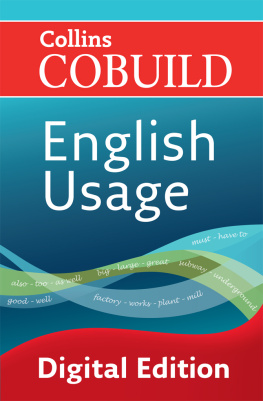
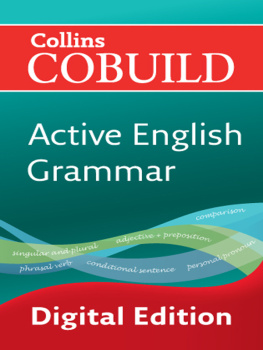
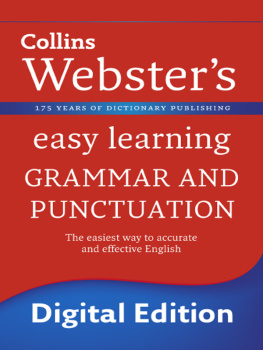


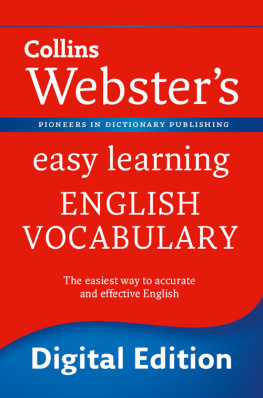
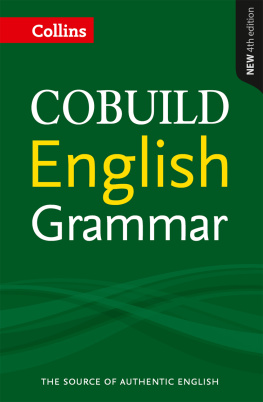
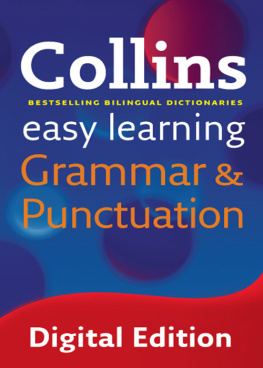
 Contents Among the Usage notes are the following Grammar Finders : Introduction Welcome to the new edition of Collins COBUILD English Usage, for students from intermediate to advanced level, and for teachers of English. With the help of the Collins Corpus, now totalling 4.5 billion words, we have been able to update and revise this title so that it describes how people actually use English now. What is usage? Usage deals with the essential details of language, involving aspects of grammar, meaning, idiom, and purpose. It looks at the way words are arranged to express a particular meaning or to do a particular job. Most of the statements in this book are not generalizations, because usage deals with all the things that are not covered by the general rules. However, there is no strict dividing line between grammar and usage.
Contents Among the Usage notes are the following Grammar Finders : Introduction Welcome to the new edition of Collins COBUILD English Usage, for students from intermediate to advanced level, and for teachers of English. With the help of the Collins Corpus, now totalling 4.5 billion words, we have been able to update and revise this title so that it describes how people actually use English now. What is usage? Usage deals with the essential details of language, involving aspects of grammar, meaning, idiom, and purpose. It looks at the way words are arranged to express a particular meaning or to do a particular job. Most of the statements in this book are not generalizations, because usage deals with all the things that are not covered by the general rules. However, there is no strict dividing line between grammar and usage.